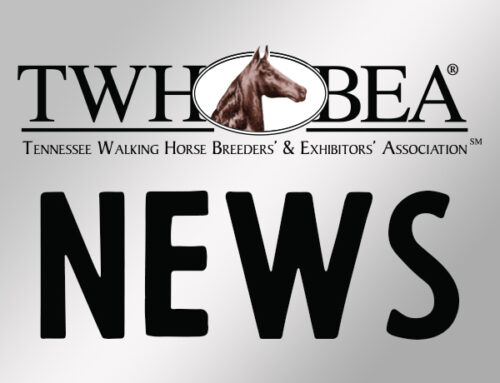TWHBEA Reaction to NAS Study
The Tennessee Walking Horse Breeders’ and Exhibitors’ Association is pleased that
the National Academies of Sciences, Engineering, and Medicine (NAS) recently concluded
their study entitled, “A Review of Methods for Detecting Soreness in Horses (2021)”,
recently published. The study, for the first time combining efforts of the USDA and the
Tennessee Walking Horse industry (Tennessee Walking Horse Breeders’ Foundation, the
USDA, and the Tennessee Department of Agriculture), was commissioned to examine
methods and approaches for detecting soring of horses and to improve the reliability of
inspections and conclusions related to soreness and soring.
The Horse Protection Act is a commerce law governing the showing, auctioning, and
exhibiting of horses that outlaws soring, defined as an action by a person that results in
physical pain to the horse. Soring is further defined as possibly including irritating or
blistering agents, burns, cuts or lacerations, or use of any tack, nail, screw, or chemical
agent used to irritate or cause pain to the limb of a horse. (Ref. 15 US Code Section 1821,
Section 3).
A variety of experienced and well-respected veterinarians with private and university
affiliations conducted the study and considered testimony and materials over a two year
period to prepare their findings in the report overseen by doctors from Michigan State
University and Washington University (St. Louis).
The NAS committee first acknowledged the stamina, gait, even disposition and
unique smooth four-beat running walk and popularity of competing Tennessee Walking
Horses, and then turned to their findings.
NAS found as a result of the study (and the Walking Horse industry and USDA
appear to agree), that the inspection system and methods involving Tennessee Walking
horses are inadequate and need to be improved through objective tests and methods.
NAS was charged to explore new methods and approaches and technology involving
inspections, with the goals of consistency, objectivity, quality and reliability. Their guiding
principle was consistent with ours – the welfare of the Tennessee Walking Horse.
We agree with NAS findings that there has been great variability and discrepancy
in inspections; experience and training vary greatly in inspectors; and inspectors may have
real or perceived conflicts of interest. The study found that this results in lack of valid and
reliable methods of inspection and fails to meet the goals of consistency, objectivity, quality
and reliability.
Even though “new methods, approaches and technology” will require further
research and development, NAS suggests that only “highly trained and experienced equine
veterinarians” would or should be examining horses, and any person not an experienced
equine veterinarian should not be doing the inspections. That is a definite step in the right
direction, and we look forward to the use of certified equine vets stepping into this role; but
we must continue to call out for, and find, better and more objective testing, as some have
voiced that this recommendation to use only qualified, experienced equine veterinarians
will be difficult and carries costs, and veterinarian opinions will vary between veterinarians
and remain subjective, thereby impeding consistency, objectivity, quality and reliability.
Although the NAS study discounts the need or desire to have a second opinion that results
in consistent findings before disqualifying a horse, we believe that insuring consistency and
reliability in inspections is always to the benefit of the horse, the exhibitor, the trainer, and
the owner.
NAS suggests that one method of obtaining objectivity, consistency, quality and
reliability is the use of blood testing and swabbing to test for chemical and/or drug
applications. We agree with NAS findings that such testing is certainly desirable when
done under appropriate circumstances and using methods that insure reliability.
NAS also examined the so-called “scar rule”. They found that the rule, as written,
and considering past interpretation and use, has been inconsistent and that “the rule is
unenforceable”. If it is to continue, it must be reexamined and rewritten. They agree that,
even if scarring is found, the cause of an established scar (not an active or raw lesion) will
not necessarily be clear, and the presence of an existing scar would not, in itself,
necessarily be a source of soreness in the animal as presented. They recommend a
revision of the rule and certain findings as necessary to enforce it. Of course, as it stands,
findings of redness, swelling, or an active lesion or raw spot would disqualify a horse from
showing; and we can call for future considerations to explore how an old scar that may not
contribute in any way to soring or reaction of pain in the animal at the time of exhibition or
training, would be viewed.
We appreciate and applaud the efforts of the USDA, the Tennessee Walking Horse
Foundation, and the Tennessee Department of Agriculture, along with the equine
veterinarians and scientists that participated, as well as those that testified and supplied
materials for the study.
In summary, this combined effort concludes in findings that current inspection
practices and methods are inadequate, makes suggestions for improvements that must be
made, and in the agreement that we must continue to search for quality objective methods,
approaches and technology that result in findings that are consistent and reliable.
Although the Tennessee Walking Horse Breeders’ and Exhibitors’ Association is not in the
business of inspecting horses, we look forward to HIOs joining in exploring and establishing
objective tests that meet the standards suggested and result in predictable, consistent, and
verifiable findings.
Copies of the full report are available from the National Acadamies Press,
Washington, D.C.; http://www.nap.edu.
Submitted by Jim Heiting, Vice President, Equine Welfare


